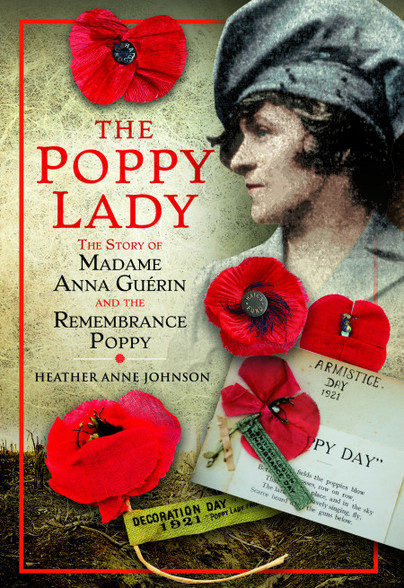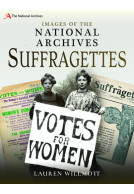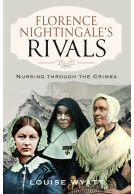The Poppy Lady (Hardback)
The Story of Madame Anna Guérin and the Remembrance Poppy
Imprint: Pen & Sword History
Pages: 288
Illustrations: 32 mono
ISBN: 9781399073721
Published: 12th December 2022
(click here for international delivery rates)
Need a currency converter? Check XE.com for live rates
| Other formats available - Buy the Hardback and get the eBook for £1.99! | Price |
|---|---|
| The Poppy Lady eBook (8.6 MB) Add to Basket | £6.99 |
Madame Anna Guérin is the fascinating personality behind the title ‘The Poppy Lady’. Her idea of the ‘Inter-Allied Poppy Day’ gave work to women and children in the devastated areas of France, in addition to offering support for First World War veterans.
Born in 1878, she was an early feminist, becoming financially independent. During the First World War, and the immediate years after the Armistice, many people knew of Madame Guérin’s reputation as a selfless fundraiser for French and American charities. Her speeches inspired many people to make generous donations.
Having had her name lost in the mists of time, this is the first biography of Madame E. Guérin. The book follows her extraordinary story as ‘The Poppy Lady’, a woman born before her time, but confined to anonymity for too long.
The brilliant red poppy worn by millions around the world on days of remembrance had to ‘begin’ somewhere and for those who stop to wonder where The Poppy Lady: The Story of Madame Anna Guéin and the Remembrance Poppy supplies a far more than adequate, and very interesting, explanation. The beautifully designed cover beckons the reader to open and learn.
Linda Granfield
Canadian soldier/doctor/poet John McCrae’s “In Flanders Fields,” another iconic remembrance piece, written in 1915, undoubtedly focused attention on the red wildflower that bloomed freely in the broken, war-ravaged battlefields of Europe both during the Great War (1914-1918) and still blooms unbidden and peppers farm fields and city sidewalk crevasses with bits of crimson. Many who delve into First World War history have heard of Britain’s Field Marshal Douglas Haig and his establishment of the Earl Haig Fund in 1921, a charity that raised money, in part through poppy sales, for the benefit of war veterans and their families. Others are familiar with the story of Miss Moina Michael, the American professor who realized, also in 1921, that those donors who left a few coins at a booth and departed with the artificial poppies decorating it could be the beginning of fundraising for America’s World War I veterans. Miss Michael was soon called “The Poppy Lady.”
There was, however, another woman who was called “The Poppy Lady”: Madame Anna Guérin, a French teacher/professional lecturer who traveled internationally during the war years and made her audiences aware of the hardships suffered by those living (especially the children) and fighting in Europe. Her fund-raising Poppy Days included replica lapel poppies in 1919. Ms. Johnson introduces readers to France’s Poppy Lady, a woman largely forgotten as Haig and Michael were remembered for their association with remembrance flowers and fund-raising.
The book is comprehensive; Johnson has impressively made ample use of thousands of contemporary newspaper articles and hundreds of pieces of ephemera while putting together this first-ever biography of Anna Guérin. A generous number of period and family photographs augments the text. While there are no footnotes/endnotes, there is a list of research materials and an index.
While a reader may find the day-by-day touring schedules and descriptions a bit tedious (as well Madame Guérin herself may have found them to be!) this book brings the forgotten Guérin and her mission to light with obvious admiration and an understanding of how ‘modern’ a woman Guérin was in both her vision and her ability to bring it to fruition. This book invites one to open at any page and enjoy the incidents there described; a consecutive page readthrough isn’t the only informative option.
In the end, the reader wonders how it is that Anna Guérin disappeared from history books and acknowledges that she well deserves to be recalled with Haig and Michael when we pause to contemplate that scarlet symbol of remembrance—the poppy.
"This book is the first biography of Madame Guerin, known as 'the Poppy Lady'. It follows her extraordinary story as a women born before her time, but confined to anonymity for too long."
AirMail - Royal Airforces Association - Autumn 2023
This book is extremely detailed, packed with facts, figures, dates, and places. It is not a novel. The reader is presented with details of the fund-raising work Anna Guérin undertook during the First World War to aid those suffering in France and the work she carried out (after the War) to promote Remembrance Poppy Days in many Allied countries, to gain funding for French widows and orphans, and how the memorial days we now hold each November came into being. For anyone interested in the history of the Remembrance Poppy it will be a worthwhile read.
Chris Stanfield
I congratulate the author’s considerable commitment to this project and I think that Mme Guérin deserves her place in the sun for all of her unstinting war and remembrance work.
Western Front Association
This is an interesting read that adds to the social historiography of the war and its aftermath.
For one of the most important days of the year I would happily recommend this book.
The History Fella
Read the Full Review Here
Throughout much of the world, each year, millions of "red poppies" are worn remembering those who have died in wars. Who inspired the idea of the manufacture of the plastic poppies that today provide employment for many war wounded disabled.
Terry Sutton
Some suggest the idea was born from Canadian John McCrae's 1915 poem Flanders Fields, where the poppies on the Flanders' battlefields grew in abundance. Other claims have originated in other parts of the world, including America.
But in a new book, The Poppy Lady, author Heather Anne Johnson submits the idea came from a French woman, Madame Anna Guerin, who was involved in helping the American wounded in World War One.
Her 275-page book (Pen and Sword-£25) details the history of Anna Guerin, her tours to persuade others to buy and where a red poppy and how the campaign was backed by the British including the (Royal) British Legion.
One interesting item is that, at one stage, in France there was a campaign not for the blood-red poppy but to get people to wear a Cornflower (le bleuet) in their Armistice Day lapels. Apparently the dainty blue flower grew profusely on the western front battlefields, along with the poppy.
If that campaign had been successful we might be wearing a cornflower in our lapel instead of a poppy.
The research for this book is thorough and the summations are superb. It is a book anyone interested in war or commemoration history needs to read and have on their shelves.
Gavin Marriott
The research for this book is thorough and the summations are superb. It is a book anyone interested in war or commemoration history needs to read and have on their shelves.
Gavin Marriott
"Wow, I am in awe of the author. All the work and research that must have gone into putting together this Poppy Lady's biography. The amount of information is outstanding. It is a real true life story and the USA played such a large part in it."
Carolyn Unger Sunn City West, AZ USA
Featured by
A Tudor Reader
Rating: 5 out of 5 stars
NetGalley, Sandra Miller
This story is of the Poppy Lady who generated the concept of adopting the Flanders Poppy to commemorate the fallen of the Great war and in the process gather funds to assist the orphaned children and families left behind on the battlefields. To follow Anna Guérin through her amazing life and extensive travels at a time when most international journeys were by sea is extraordinary and demonstrated her exceptional determination and fortitude to sustain her campaign to all the major Allied countries involved in WWl. The book dispels some modern day myths as to why the Poppy is the flower of commemoration and remembrance and as you continue to read you can tell that Anna does not take no for an answer and she is astute enough to gain patronage from powerful men, Presidents for example, and influential women who form the force of getting the Flower sellers on the streets to raise the funds, even in hard times.
A very enjoyable book and a must read for anyone connected with the Legion wherever they may be.
Rating: 5 out of 5 stars
NetGalley, Ece Karadag
Madame Anna Guérin (born Anna Alix Boulle) is the intriguing character behind the title 'The Poppy Lady.' Her concept of the 'Inter-Allied Poppy Day' provided employment for women and children in devastated areas of France, as well as support for WWI veterans. She was an early feminist, becoming financially independent after being born in 1878. Many people were aware of Madame Guérin's reputation as a selfless fundraiser for French and American charities during the WWI and the years following the Armistice. Many people were moved to give generously as a result of her speeches.
Madame Anna Guérin (born Anna Alix Boulle) was the founder of Remembrance Poppy Day. She previously worked as a teacher in Madagascar, as a lecturer for the Alliance Française, and as a fundraiser and humanitarian in the United States during WWI. She received the Officier d'Académie' médaille and the Officier de l'Instruction Publique médaille for her services to France. The Victory Liberty Loan Medallion was awarded to her for her services to the United States and for the Liberty Bond. Her plan was for all WWI Allied countries to use artificial poppies made by French widows and orphans as an emblem for remembering those who died during the war while also creating a method of raising funds to support the families of the fallen and those who survived. The Remembrance Poppy now encompasses all subsequent conflicts.
For the first time in France, on November 11, 2021, the Office national des anciens combattants et victimes de guerre (ONACVG) and the local authorities organized a ceremony in Aubigny-sur-Nère, where a place was dedicated to the French Lady Poppy.
About Heather Johnson
HEATHER JOHNSON has an interest in local and inter/national history. She researches her own genealogy and enjoys enlightening others to theirs. Since 2013, she has researched the British WW1 Home Hospitals set up close to her East Anglia home. Skills honed in these endeavours proved invaluable when a proud Canadian, Nancy MacFarlane, asked “who put the poppy on your lapel?” She identified “The Poppy Lady of France” and it is Heather’s mission to bring her out of the shadows.















